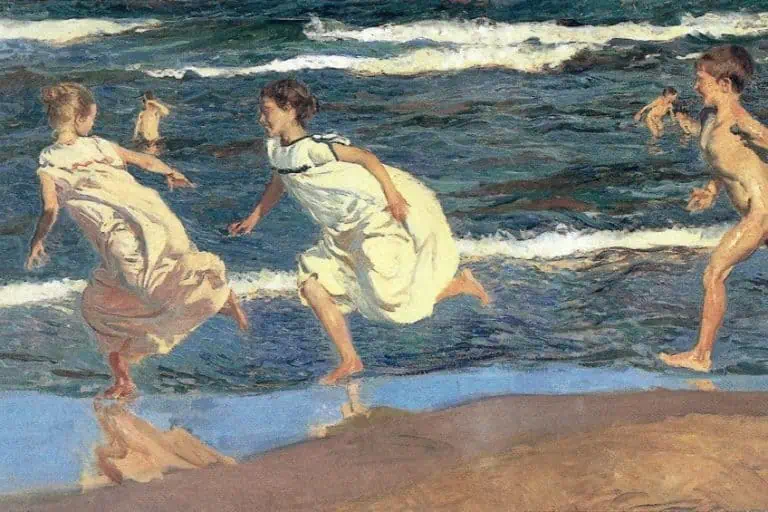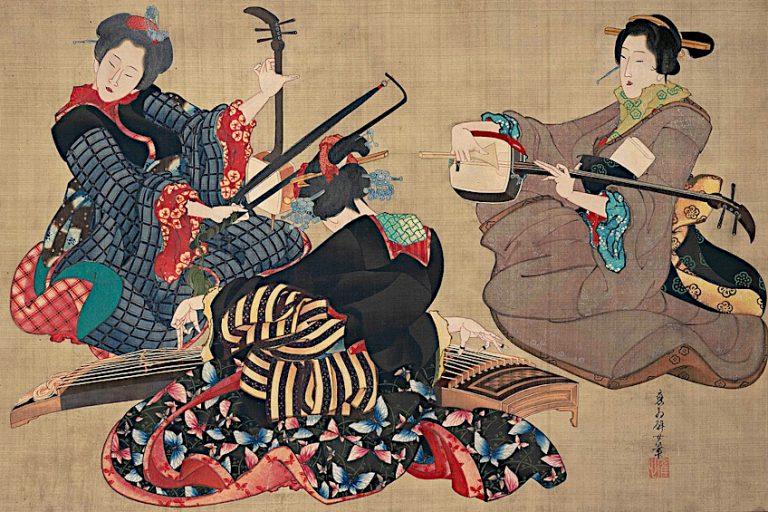Kintsugi – The Japanese Art of Golden Joinery
This post may contain affiliate links. We may earn a small commission from purchases made through them, at no additional cost to you.
Many have a favorite vase, bowl, teapot, or ceramic antique item that they treasure. However, sometimes it can accidentally break, which can be upsetting. Our first reaction might be to sweep up the broken pieces and throw them away. But what if there is an alternative? The ancient Japanese art of Kintsugi enhances and highlights the breaks in objects, adding some value to an otherwise worthless and broken piece of pottery. Let us take a closer look at what kintsugi is.
Table of Contents
Kintsugi Meaning
What is Kintsugi? This is an ancient Japanese art form of putting broken pieces of pottery together, which does not overlook all the imperfections, but rather embraces them. Not one piece of broken pottery is the same, each one is unique. The process is also not about using super glue and trying to cover up the cracks. Instead of concealing the flaws, Japanese Kintsugi highlights the imperfections and creates a brand-new design, even stronger and more beautiful than before.
The Kintsugi or Kintsukuroi technique uses a special Urushi tree sap lacquer and mixes it with powdered silver, platinum, or gold. This is then used to join all the broken pieces together, enhancing the breaks and giving the ceramic item a new lease on life.
 Woodblock print by Utagawa Kuniyoshi showing a group of workers harvesting Urushi tree lacquer (1852); British Museum, Public domain, via Wikimedia Commons
Woodblock print by Utagawa Kuniyoshi showing a group of workers harvesting Urushi tree lacquer (1852); British Museum, Public domain, via Wikimedia Commons
Some might even deliberately smash an item, so they can create a new and unique design of Kintsugi pottery. We can learn from this technique, as a metaphor, it can mean healing for ourselves. At times when we have been broken by circumstances, the process of healing can produce something unique, resilient, and beautiful.
Brief History of Kintsugi or Kintsukuroi
The exact date when Kintsugi or Kitsukuroi originated is not very clear, but most historians believe that it can be traced back to the late 15th century. There is an old Japanese legend that confirms the origins of Kintsugi. When Ashikaga Yoshimasa (1436 – 1490), a Japanese shogun (Japanese military leader) accidentally broke his “chawan” or tea bowl, it was sent back to China for replacement.
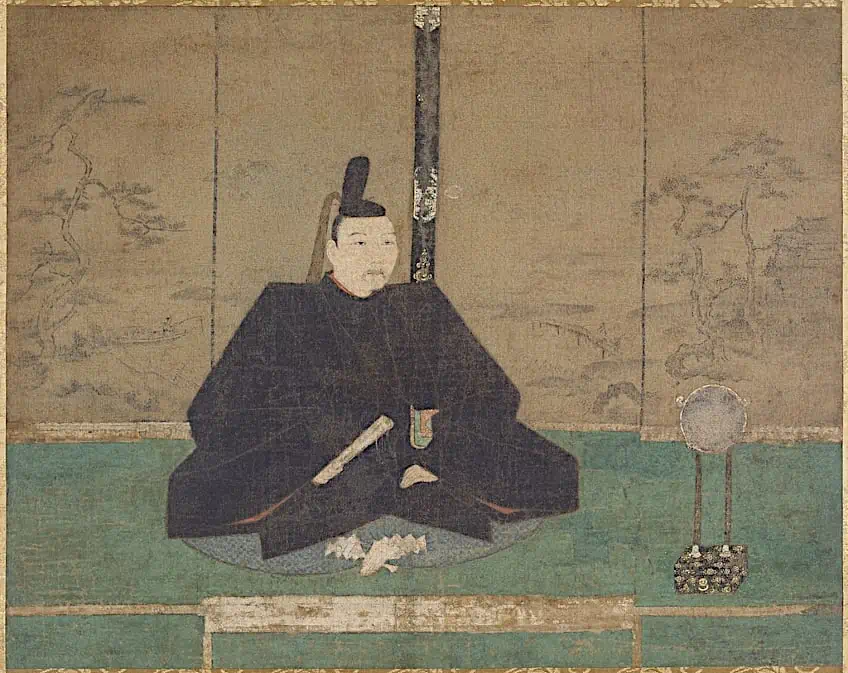 Detail of a portrait believed to be of Ashikaga Yoshimasa attributed to Tosa Mitsunobu (late 15th Century); 日本語: 伝土佐光信English: Attributed to Tosa Mitsunobu, Public domain, via Wikimedia Commons
Detail of a portrait believed to be of Ashikaga Yoshimasa attributed to Tosa Mitsunobu (late 15th Century); 日本語: 伝土佐光信English: Attributed to Tosa Mitsunobu, Public domain, via Wikimedia Commons
The Chinese advised him that the cup was so rare, and instead of replacing it, they decided to repair it, which was done using metal staples. When the repairs were completed and sent back to him, Yoshimasa was very dissatisfied, as it looked unsightly.
It appeared that his cup was irreparable, but he decided to give it to some Japanese craftsmen to see if they could repair it. The craftsmen were very surprised but decided to repair it using lacquered resin and powdered gold to fill in the cracks, and so Kintsugi or Kitsukuroi was born.
Around the 17th century, Kintsugi art had become a common practice all over Japan. At the same time, it was recorded that a Japanese warrior purposely bought ceramic cracked pots or vessels so he could repair them and sell them for a profit as Kintsugi pottery.
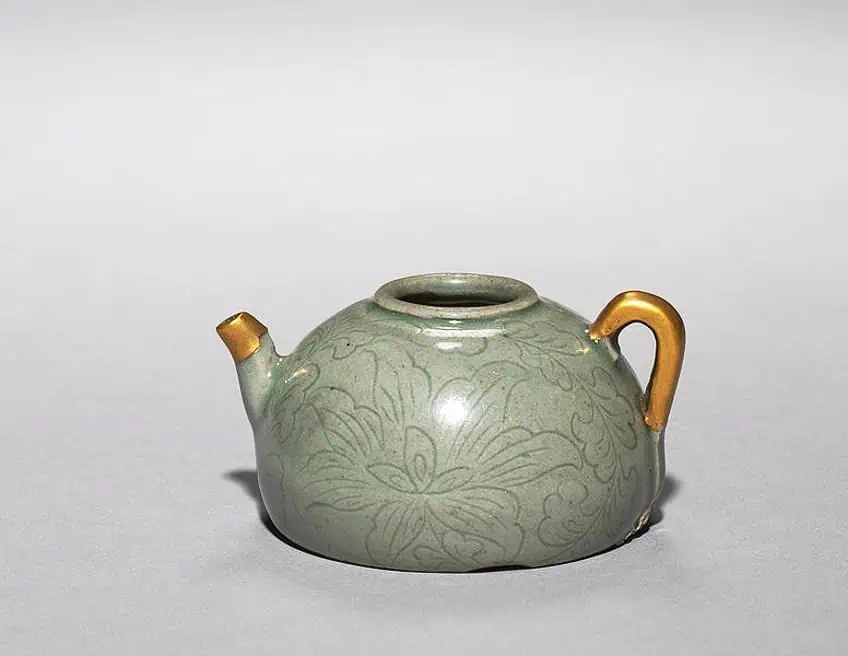 12th Century Wine Ewer with Incised Scroll Design with an early 20th Century Kintsugi repair; Cleveland Museum of Art, CC0, via Wikimedia Commons
12th Century Wine Ewer with Incised Scroll Design with an early 20th Century Kintsugi repair; Cleveland Museum of Art, CC0, via Wikimedia Commons
The Art of Kintsugi
The age-old Japanese Kintsugi technique uses broken pieces of pottery that are joined together again with gold, transforming the pottery into a brand-new work of art. Kintsugi, also known as Kintsukuroi, can be broken down into two words. There is “kin”, which means golden, and then “tsugi”, which means repair or joined.
 Korean tea bowl from the Joseon dynasty 16th Century) repaired using the Kintsugi technique; Daderot, CC0, via Wikimedia Commons
Korean tea bowl from the Joseon dynasty 16th Century) repaired using the Kintsugi technique; Daderot, CC0, via Wikimedia Commons
The cracks or scars of the Japanese broken pottery become the focal point that turns it into a unique and exquisite piece of art. You may have some ceramic cracked pots or a broken vase or pottery vessel that needs to be repaired. Instead of getting rid of it, why not restore it using the Kintsugi technique? All you need to do is follow the tutorial below and you can create your own Kintsugi masterpiece.
The Kintsugi Technique
The conventional technique of Kintsugi, practiced by the Japanese, use Urushi tree lacquer mixed with rice flour. This mixture was able to bind the broken pieces of pottery together again.
Today, you may not have access to the same type of materials, but we will be guiding you through the whole process.
You may not have a broken dish at hand, so take one of your cups or dishes you do not mind breaking, place it in a plastic bag, and lightly tap it with a hammer until it breaks. Carefully remove all the broken pieces, and you are ready to start your own Kintsugi ceramic repair technique. The items you need, will include the following:
- Liquid gold leaf or gold mica powder
- Clear epoxy resin or an alternative ceramic adhesive
- Thin small disposable paintbrush
- Piece of scrap paper
- Broken pottery or ceramic dish
- Paper bag, which is optional
- Optional Hammer
- Optional masking tape

Select Your Kintsugi Bowl
Choose the ceramic bowl you want to repair, but ensure it is a dish that is used for decorative purposes and not used for beverages or food, as the epoxy resin can be toxic when consumed. Now that you have selected your Kintsugi bowl, you need to decide which of the three techniques or methods of Kintsugi you are going to apply.
- The crack technique or method: Here you glue all the pieces together with golden adhesive. This is the most common method used.
- The Makienaoshi technique or method: Where all the pieces are made up of epoxy to replace any missing parts. This is used where the item is broken beyond repair.
- The joint technique or method: You can combine broken pieces of ceramics from different items, making one new item.
Prepare Your Adhesive
If you are going to make use of gold mica powder, you need to take a piece of scrap paper and mix equal amounts of the gold mica powder and resin. Do not make this mixture until you are ready to glue the pieces, as it cures very quickly. If you are going to make use of liquid gold leaf, then you will only need the epoxy resin, and keep the gold leaf for the final step.
Gluing Your Ceramic Item Together
Using the paintbrush, apply the resin to the broken edges of your item and push them back into place. It may be a good idea to first assemble the broken pieces before you start gluing, this will make the process a lot easier.
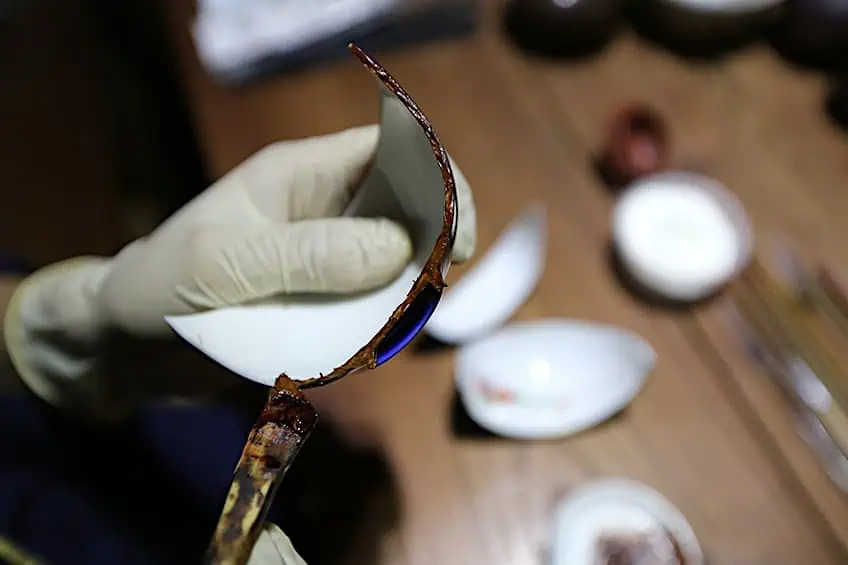
If you assemble the item and discover you have a piece missing, leaving a gap, then you need to follow the Makienaoshi technique. Place a piece of masking tape on one side of the ceramic item where there is a gap, then begin to fill the gap with the epoxy resin.
Creating Gold Lines
When creating the appearance of Japanese gold cracks using gold mica powder, you need to sprinkle some of the powder onto the surface just before the adhesive begins to set. This will give the gold a brighter finish. To prevent the gold mica powder from attaching itself to the dish, apply masking tape on both sides of the crack.
When using liquid gold leaf, you need to give the adhesive a chance to dry first, around 10 to 15 minutes, before you start to paint on the lines. If you used gold mica powder, then you can also use the liquid gold leaf to give your dish an even better Kintsugi effect.
If you want a more subtle or delicate look, then take a knife and scrape some of the thicker layers of resin off, this needs to be done before you paint the lines. Now allow your dish to completely set, around two days, and you can then exhibit your new Kintsugi art piece in your home.
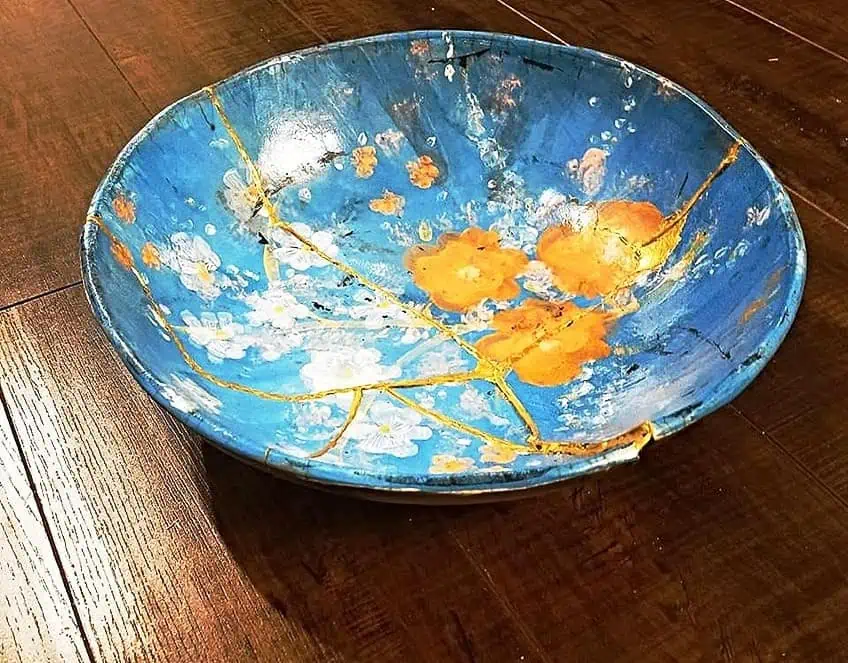 Modern hand-painted Kintsugi Pottery Bowl by Ruthann Hurwitz; Ruthann Hurwitz, CC BY-SA 4.0, via Wikimedia Commons
Modern hand-painted Kintsugi Pottery Bowl by Ruthann Hurwitz; Ruthann Hurwitz, CC BY-SA 4.0, via Wikimedia Commons
The Philosophy of Kintsugi
The Kintsugi meaning and how it can relate to our lives. Not only is Kintsugi appealing, but it also involves a transformation of something broken and worthless into something new. This can also represent many philosophical ideas that are relevant to our daily lives. Like pottery that is often subjected to knocks, breaks, and shattering blows, so too are our daily lives subject to similar misfortune.
We are also subject to pain and physical as well as emotional damage in our lives. Kintsugi teaches us about healing for ourselves. The process in our lives can also involve the creation of new life and beauty in a situation that appears to be hopeless. Like the phoenix, we can emerge stronger. As the saying goes, “beauty for ashes”.
We need to learn to look for ways in which to cope with any traumatic events that come into our lives, in a better and positive way, and not to dwell on the negative experiences. We need to take the best from every experience and believe that those experiences are going to make us better and more unique people.
Wabi-Sabi
The Kintsugi technique is closely related to the Japanese philosophy of Wabi-sabi, which states that something beautiful can be created out of an imperfect situation. Embracing our imperfections or weaknesses means that we are embracing all of ourselves, making us stronger. This Japanese philosophy of Wabi-sabi shows us how the Kintsugi technique can be effective in our everyday lives.
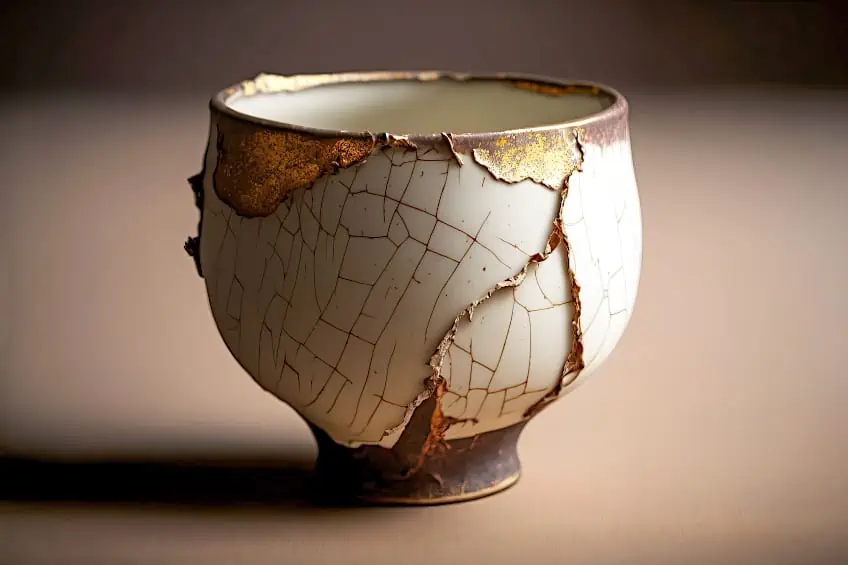 Wabi Sabi Cup created using Kintsugi techniques; stock image
Wabi Sabi Cup created using Kintsugi techniques; stock image
The Cultural Significance of Kintsugi
Kintsugi philosophy or culture teaches us that wellness of body and mind is all about practicing resilience and learning to overcome life’s challenges, and coming out better people even with all the “golden cracks”. Just like Wabi-sabi, there are more Japanese philosophies that we can consider, which show us how the Kintsugi technique can be a type of metaphor for our everyday lives.
 Detail of a repair using Kintsugi; Haragayato, CC BY-SA 4.0, via Wikimedia Commons
Detail of a repair using Kintsugi; Haragayato, CC BY-SA 4.0, via Wikimedia Commons
Gaman
Gaman is the ability to be patient, endure and remain calm in our lives. When we are in challenging circumstances like a divorce or just trying to cope with a stressful week at work, the practice of Gaman encourages us not to focus on the negative, but tap into our inner strength and rather focus on our potential.
Yuimaru
Yuimaru is the practice of togetherness, where we can find help and support from friends and family. So, taking care of the inner circle of family and friends helps us to take care of and love ourselves.
 Yuimaru and Kintsugi are principles associated with building resilience; stock image
Yuimaru and Kintsugi are principles associated with building resilience; stock image
Eiyoshoku
Eiyoshoku teaches us to nourish our bodies, and in so doing, produce a positive mind. This philosophy shows us that the body and the mind are closely linked through what types of food we eat. So, following a healthy diet with the correct foods will lead to a healthy mind. In the same way, when we eat unhealthy foods, our minds do not benefit from this.
Kansha
Kansha is most probably the most important of all the Kintsugi philosophies, which is expressing gratitude, whether it is for good or for bad. To learn to be grateful for what you have and stop undermining your happiness by yearning for things you do not have. It is the opposite of a consumer culture that values the excitement of buying something new over the preservation of what you already own.
 Kansha and Kintsugi principles are associated with appreciation of what you already have; stock image
Kansha and Kintsugi principles are associated with appreciation of what you already have; stock image
Gratitude is accepting the good as well as the bad, everything happens for a reason, and nothing crosses our path without a purpose. The sole purpose is for us to become better and more resilient and grateful.
Kintsugi Beyond Pottery
What influence has Kintsugi had on contemporary artists today? In today’s world, the art of Kintsugi has a huge influence on artists from all corners of the globe, where they bring an interpretation of the Kintsugi technique into their art styles.
The Influence of Kintsugi on Art
The artist Rachel Sussman (born 1975) applies the Kintsugi, or Kintsukuroi technique in her street art, where she goes around and finds cracks on the pavement or in the street. She then fills the cracks using gold pigment. Finally, she makes copies of the street art, which she then sells.
Another artist using the Kintsugi technique in her art is Paige Bradley (born 1974). Her art medium is sculpture, and she chooses illumination or light to fill all the cracks in the body of her sculptures. She states that for our lives to be complete, there needs to be an element of imperfection and chaos.
Paige Bradley uses light to highlight the “Japanese gold cracks” in the human body and so accepts the weakness and imperfections not as something dead, but rather giving life through light.
The Influence of Kintsugi on Fashion
The Kintsugi technique has also been explored in the fashion industry, as seen by British artist Karen Lamonte, who takes different pieces of fabric and mends or combines them in her designs. She finds her inspiration from the Japanese culture of Kintsugi.
 Sculpture by Karen LaMonte created using traditional Kintsugi techniques; Karen LaMonte, CC BY-SA 4.0, via Wikimedia Commons
Sculpture by Karen LaMonte created using traditional Kintsugi techniques; Karen LaMonte, CC BY-SA 4.0, via Wikimedia Commons
The New York designer George Inaki Root created a special line of jewelry that he called Kintsugi. This involves several of the Kintsugi techniques from Japanese culture and traditions. There is also Victor Solomon, who was inspired by the concept of the Kintsugi technique and used it to repair a fractured basketball court in Los Angeles in 2020.
We hope, after you have gone through this article, that you have gained some understanding of the concept of Kintsugi. Instead of throwing a broken bowl away, try to fix it next time and let it become something new.
Frequently Asked Questions
What Benefits Does Kintsugi Offer?
Kintsugi teaches us that instead of looking at something that is broken and disregarding it, let us rather act on the situation and fix it. Then, even with all its imperfections, it now becomes a thing of beauty.
Why Is Gold Used in Kintsugi?
The use of gold to highlight mends on broken ceramic vessels is an old Japanese tradition that brings new life to a broken vessel, making the imperfect perfect and a thing of beauty. The gold also adds value to the Japanese broken pottery.
Can You Practice Kintsugi at Home?
If you want to do Kintsugi at home, all you need to do is buy an at-home Kintsugi kit that has all the necessary equipment in it. You can also start from scratch, by taking two parts of clear ceramic adhesive and mixing it with one part of gold mica powder, and then you are ready to do your own Kintsugi repairs.
In 2005, Charlene completed her wellness degrees in therapeutic aromatherapy and reflexology at the International School of Reflexology and Meridian Therapy. She worked for a company offering corporate wellness programs for several years before opening her own therapy practice. In 2015, she was asked by a digital marketer friend to join her company as a content creator, and it was here that she discovered her enthusiasm for writing. Since entering the world of content creation, she has gained a lot of experience over the years writing about various topics such as beauty, health, wellness, travel, crafting, and much more. Due to various circumstances, she had to give up her therapy practice and now works as a freelance writer. Since she is a very creative person and as a balance to writing likes to be active in various areas of art and crafts, the activity at acrylgiessen.com is perfect for her to contribute their knowledge and experience in various creative topics.
Learn more about Charlene Lewis and about us.


